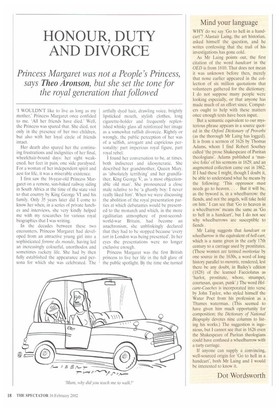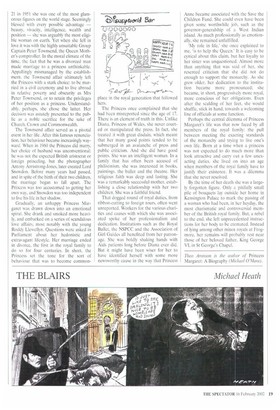HONOUR, DUTY AND DIVORCE
Princess Margaret was not a People's Princess,
says Theo Aronson, but she set the tone for
the royal generation that followed
'I WOULDN'T like to live as long as my mother,' Princess Margaret once confided to me. 'All her friends have died.' Well, the Princess was spared that. She died, not only in the presence of her two children, but also with her loyal circle of friends intact.
Her death also spared her the continuing frustrations and indignities of her final, wheelchair-bound days: her sight weakened, her feet in pain, one side paralysed. For a woman of her independent spirit and zest for life, it was a miserable existence.
I first saw the 16-year-old Princess Margaret on a remote, sun-baked railway siding in South Africa at the time of the state visit to that country by King George VI and his family. Only 35 years later did I come to know her when, in a series of private lunches and interviews, she very kindly helped me with my researches for various royal biographies that I was writing.
In the decades between these two encounters, Princess Margaret had developed from an attractive young girl into a sophisticated femme du monde, having led an increasingly colourful, unorthodox and sometimes rackety life. She had by then fully established the appearance and persona for which she was celebrated. The artfully dyed hair, drawling voice, brightly lipsticked mouth, stylish clothes, long cigarette-holder and frequently replenished whisky glass all reinforced her image as a somewhat raffish divorcée. Rightly or wrongly, the public perception of her was of a selfish, arrogant and capricious personality: part imperious royal figure, part royal rebel.
I found her conversation to be, at times, both indiscreet and idiosyncratic. She described her grandmother, Queen Mary, as 'absolutely terrifying' and her grandfather, King George V, as 'a most objectionable old man'. She pronounced a close male relative to be 'a ghastly boy: I never really liked him'. When we were discussing the abolition of the royal presentation parties at which debutantes would be presented to the monarch and which, in the more egalitarian atmosphere of post-secondworld-war Britain, had become an anachronism, she unblinkingly declared that they had to be stopped because 'every tart in London was being presented'. In her eyes the presentations were no longer exclusive enough, Princess Margaret was the first British princess to live her life in the full glare of the public spotlight. By the time she turned 21 in 1951 she was one of the most glamorous figures on the world stage. Seemingly blessed with every possible advantage — beauty, vivacity, intelligence, wealth and position — she was arguably the most eligible woman on earth. Yet when she fell in love it was with the highly unsuitable Group Captain Peter Townsend, the Queen Mother's comptroller. In the moral climate of the time, the fact that he was a divorced man made marriage to a princess unthinkable. Appallingly mismanaged by the establishment, the Townsend affair ultimately left the Princess with a stark choice: to be married in a civil ceremony and to live abroad in relative poverty and obscurity as Mrs Peter Townsend, or to retain the privileges of her position as a princess. Understandably, perhaps, she chose the latter. Her decision was astutely presented to the public as a noble sacrifice for the sake of Church. Crown and Commonwealth.
The Townsend affair served as a pivotal event in her life. After this famous renunciation, her behaviour became increasingly wayward. When in 1960 the Princess did marry, her choice of husband was unconventional: he was not the expected British aristocrat or foreign princeling, but the photographer Antony Armstrong-Jones, later created Lord Snowdon. Before many years had passed, and in spite of the birth of their two children, the marriage began to fall apart. The Princess was too accustomed to getting her own way, and Snowdon was too independent to live his life in her shadow.
Gradually, an unhappy Princess Margaret was drawn down into an emotional spiral. She drank and smoked more heavily, and embarked on a series of scandalous love affairs, most notably with the young Roddy Llewellyn, Questions were asked in Parliament about her hedonistic and extravagant lifestyle. Her marriage ended in divorce, the first in the royal family to do so for four centuries. In short, the Princess set the tone for the sort of behaviour that was to become common place in the royal generation that followed hers.
The Princess once complained that she had been misreported since the age of 17. There is an element of truth in this. Unlike Diana, Princess of Wales, she never courted or manipulated the press. In fact, she treated it with great disdain, which meant that her many good points tended to be submerged in an avalanche of press and public criticism. And she did have good points. She was an intelligent woman. In a family that has often been accused of philistinism, she was interested in books, paintings, the ballet and the theatre. Her religious faith was deep and lasting. She was a remarkably successful mother, establishing a close relationship with her two children. She was a faithful friend.
That dogged round of royal duties, from ribbon-cutting to foreign tours, often went unreported. Workers for the various charities and causes with which she was associated spoke of her professionalism and dedication. Institutions such as the Royal Ballet, the NSPCC and the Association of Girl Guides all benefited from her patronage. She was boldly shaking hands with Aids patients long before Diana ever did. But it might have been wiser for her to have identified herself with some more newsworthy cause in the way that Princess Anne became associated with the Save the Children Fund. She could even have been given some worthwhile job, such as the governor-generalship of a West Indian island. As much professionally as emotionally, she remained unfulfilled.
'My role in life,' she once explained to me, is to help the Queen.' It is easy to be cynical about this claim, but her loyalty to her sister was unquestioned. Almost more than anything that was said of her, she resented criticism that she did not do enough to support the monarchy. As she grew older, her dedication to the institution became more pronounced; she became, in short, progressively more royal, more conscious of her obligations. Even after the scalding of her feet, she would shuffle, stick in hand, towards a welcoming line of officials at some function.
Perhaps the central dilemma of Princess Margaret's life was that now faced by all members of the royal family: the pull between meeting the exacting standards of the monarchy and trying to live one's own life. Born at a time when a princess was not expected to do much more than look attractive and carry out a few unexacting duties, she lived on into an age when members of the royal family have to justify their existence. It was a dilemma that she never resolved.
By the time of her death she was a largely forgotten figure. Only a pitifully small pile of bouquets lay outside her home in Kensington Palace to mark the passing of a woman who had been, in her heyday, the most charismatic and controversial member of the British royal family. But, a rebel to the end, she left unprecedented instructions for her body to be cremated. Instead of lying among other minor royals at Frogmore, her remains will probably rest near those of her beloved father, King George VI, in St George's Chapel, Theo Aronson is the author of Princess Margaret: A Biography (Michael O'Mara).





































































 Previous page
Previous page